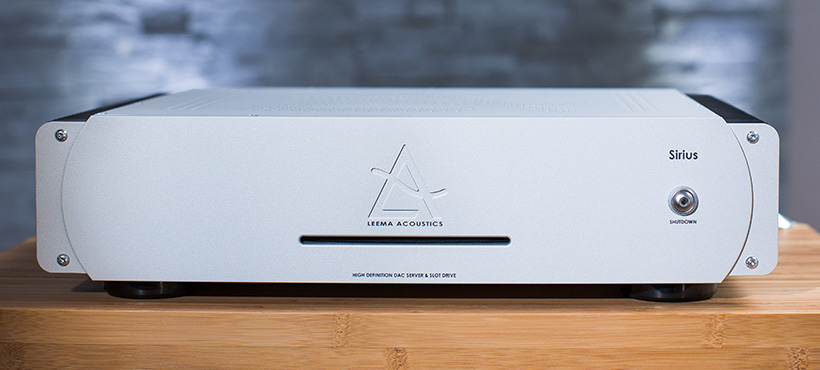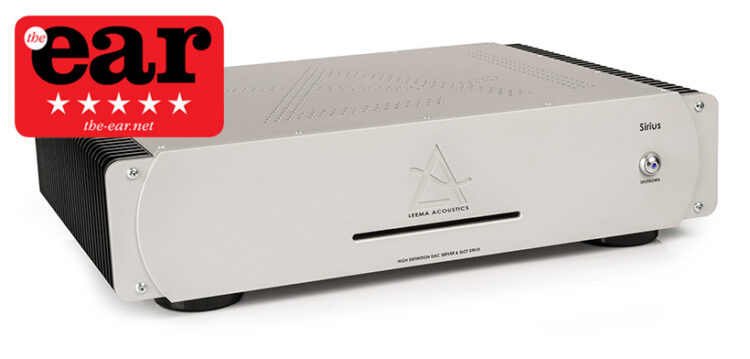If you want digital audio that can compete with the best of analogue get yourself a dedicated audio server, a data store for the bits ripped from CDs or high res downloads. See our reviews of servers by Innuos and Melco to get some idea of what such supercharged NAS drives can achieve. Yet they all require attachment to a DAC and/or network streamer to function. Just as a turntable needs a phono stage a server needs a DAC and preferably a streamer with built in DAC.
Leema have looked at this conundrum and found a solution by putting a DAC in the same box as the server. This eliminates a digital connection, which is always a good idea as such things usually undermine performance, and makes a direct link between source and converter. Saving on hardware and the costs and space associated with it. The Sirius is built around an Innuos Zen MkII network server, which is a very good piece of kit indeed, one of the best on the market in fact. It offers 2TB HDD spinning disc storage driven by a Quad core Intel CPU with 4GB of RAM and features dual ethernet ports so that you don’t need a network switch when running a streamer. For direct connection to an external DAC there is a USB output alongside another for back up (always a good idea especially if you can get round to it). It has an onboard disc ripping drive and the option to choose between ripping modes (FLAC or WAV). Set up is via the my.innuos web interface and playback control can be done with any Squeezebox compatible app, Leema recommends iPeng for iOS and OrangeSqueeze for Android. Alternatively the Sirius can be used as a Roon core which means that Roon’s enviable control app can also be used if you have a subscription.

What Leema has done is replace the power supply for the drive motors and installed an additional DC supply for the motherboard, they also spec twice the RAM of the standard Zen MkII. You can upgrade storage in 2TB increments to a maximum of 8TB for all file types. They have also built a digital to analogue converter into the Sirius using an ESS Sabre 9028 Pro DAC which Lee Taylor at Leema calls “frankly the best DAC we have deployed thus far”, which given that his company makes a high end standalone DAC in the Libra is saying something. It has an XMOS interface and supports PCM UP TO 32-bits/384kHz and DSD256 that output via single ended and balanced outputs. The combination of analogue and ethernet outputs means that the Sirius can be used as the server for a multi-room system at the same time as offering a dedicated source for a two channel main system. Given the presence of the onboard DAC it would have been nice for the Sirius to have inputs for other sources but that would require some means of selecting between them which would require mechanical switching. There’s only one fly in the ointment and that’s that Innuos has discontinued the Zen MkII with a MkIII version due any time now. Lee says that Sirius will remain based on the MkII unless there is a significant improvement with the new unit.
Sound quality
We auditioned the Sirius via its onboard DAC, and to be frank this is the only reason to buy this product given that an Innuos Zen is less than half the price albeit without the fancy casework. The results were very appealing indeed, the Sirius has a light touch that is rare in digital audio, it seems to leave very little mark on the music by neither adding nor detracting from the signal. Initially it seems to lack drive and dynamic contrast but after a while it becomes apparent that you get to hear more of the music and less of the processing character that so often besets digital audio. I should point out that we listened via a preamplifier rather than using the digital volume control on the DAC, the latter are useful for uncritical listening or quick mutes but are generally best left all the way up.
Back with the music, I love the way that you get so much openness with the Sirius, it seems to let a lot more light in than usual which shows up all the texture and subtleties in the music. The bass is also unusually natural which could be interpreted as light or lacking in weight with some tracks but extended listening reveals it to be really well balanced especially with acoustic bass sources. Drum solos for instance have plenty of energy and power with no sense of tuning or tweaking in the balance to make the bass seem more muscular. Congas and other hand beaten drums are very solid in the room as are brass instruments, in fact the whole band on Conjure’s Music for the Texts of Ishmael Reed (American Clavé) are rendered in colourful 3D. Rhythmically the Sirius is a little restrained, it doesn’t drive the beat in the way that some DACs do but gives even weight to melody, tempo and dynamics in a distinctly natural, dare I say it neutral fashion. There will be those who prefer a more powerful sense of timing, it’s something I really enjoy myself, but Leema have given Sirius something that seems more transparent to the character of the music and it works well.

Beethoven’s 5th lacks a little of its power and seems slightly polite through the midrange but it’s easy to appreciate the spaciousness and depth in the recording. The Michael Wollny Trio’s Live in Wartburg is a great recording and this player lets you hear it in cleaner fashion than most. Again dynamics aren’t maxxed but the drums sound a bit more natural than usual, it’s as if other DACs emphasise dynamics but get overwhelmed when the real thing comes along. In practice it means that you can play the Sirius at higher levels without discomfort and drums have real kick when the recording is this good. When the signal is clean you can let the amplifier and speakers reveal the dynamics, and the rhythm for that matter, which comes through very clearly at higher playback levels.
Quieter material like John Martyn’s ‘Head and Heart’ (BBC Radio 1 Live in Concert) is sublime, simple but so effective thanks to the high level of transparency that combining source and conversion provides. This was originally the way with CD players of course, but they have the tricky task of reading an optical disc and turning the results into a PCM signal, a server has the PCM (or DSD) signal ready to stream to the DAC with high precision clocking and thus has a significant advantage.
There are other server/DAC combinations on the market, Naim’s HDX was one of the first but is no longer in production and Bluesound’s Vault 2 offers 2TB and a DAC for £1,099. So the Sirius is not alone but it does have a serious power supply for both server and DAC, and is built by a company with a proven track record. It also brings unusually low perceived distortion to the table by virtue of combining high quality examples of server and DAC technology. And of course you can always upgrade with an external DAC and/or streamer if the urge takes you.


